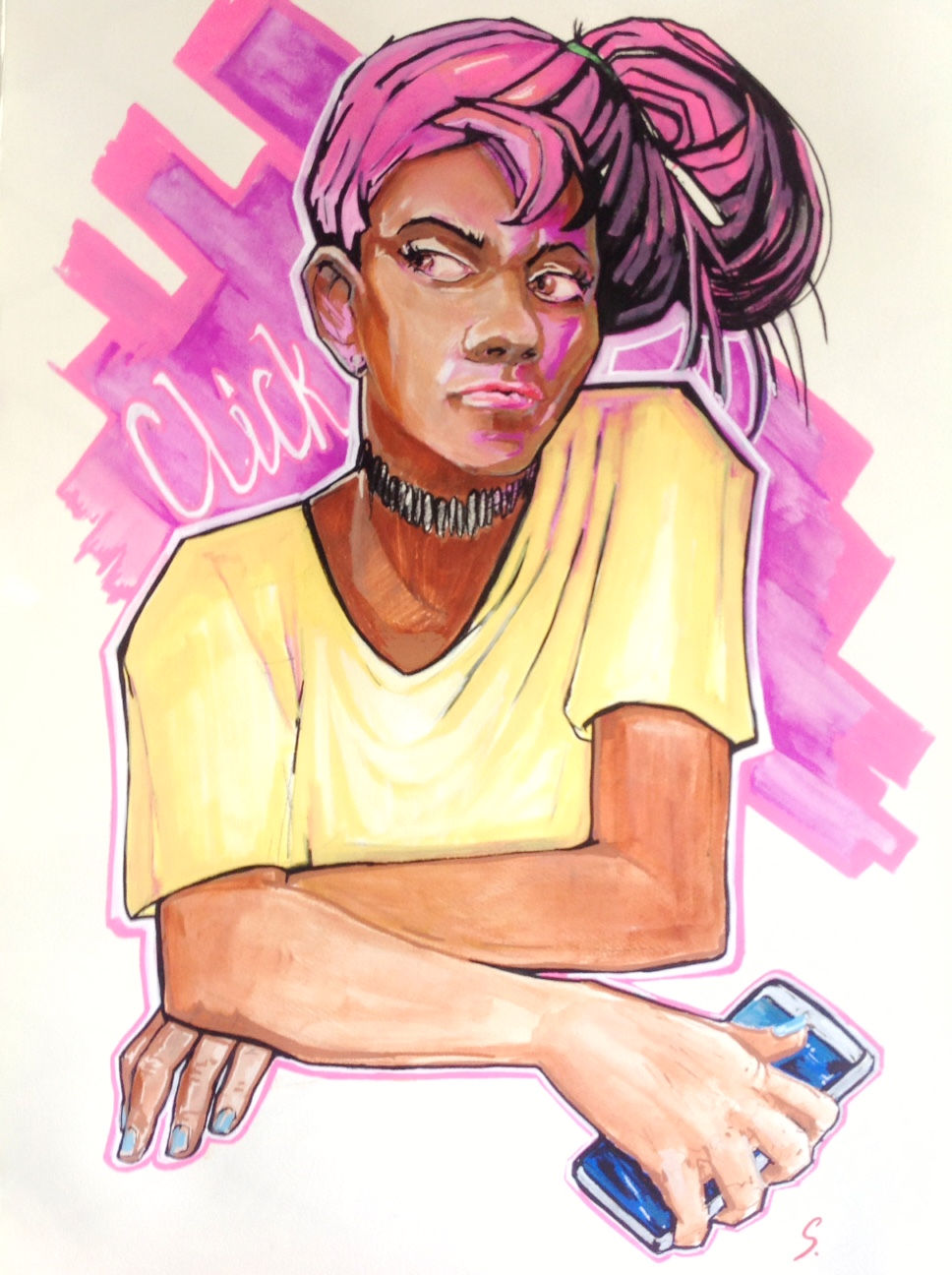TRANSCENDING THE TEMPLATE
- Emma Schuberg
- Dec 14, 2017
- 4 min read
Shilo McNamee

Shilo McNamee's Phonecall is a working investigation into the low-tech, handmade process of local art making. In this interactive series, the analogue is presented in dialogue with aspects of our digital times. Phonecall is comprised of three works on paper, a flip book which is turned by the hand of the audience, and a sort of paddle hooked up with rubber bands that invites experiments with spin, motion and getting the image to ‘move’.
McNamee explains she is exploring sequential art in different formats, and reflects, "I want the images to be bigger and closer together next time, perhaps more like a comic strip; this might help frame the static pieces and link things better."
It’s a lively sequence, and McNamee has used mixed media, Posca pens, and acrylic glazes that work-up a kind of party mood evocative of an 80s summer hits compilation cassette cover. The goal for Phonecall was to simply convey a moment in time. A young Indigenous woman with pink hair and dark skin waits for the mobile phone to ring. She is bored. Her fingers tap beats on the table. An unknown caller rings – Hello? ‘Click’ is the final panel. The call was a disappointment.
McNamee's choice of subject, its depiction and execution is deliberate. She conjures the figurative and narrative from her mind, but she constructs in resistance: "I am conscious of representing a truly Territory-based figure. I reflect on the people who live here. We look different, speak differently and dress differently.” McNamee’s own heritage is Greek and Aboriginal. “As a trained artist, the default is to portray the perfect Caucasian – strong bone structures with perfectly proportioned and aligned facial features. ‘How to draw’ books provide you with formulas to memorise, on how to construct the perfect face. I wasn’t expecting to struggle so much in depicting a ‘non Anglo’ face. The question I posed to myself was, why? – when I can draw 'my own' face, from around here in a true way? Different people, different looks. Darwin is different to everywhere else. Our art should be too."
Shilo McNamee is the Gallery Manager at Darwin Visual Arts Association, and holds a Bachelor of Creative Arts from Charles Darwin University. She was recently selected to attend a professional development program at the Venice Biennale, one of the premier events in the global art world calendar. She had two pairs of sandals blow-out on the cobblestone streets, and a third on its last straps. Caught walking without shoes through the old city, she drew quite a bit of varied reaction: no one, it seems, walks barefoot through Venice.
Megan Adams

Megan Adams moved to Darwin a couple of years ago, and has found the city rich in contradiction. The Territory has impacted Adams’ work as an artist, particularly in her day to day role around Aboriginal students — a context that helps her process and engage as a local artist. Her recent portrait of Adam Goodes garnered national mainstream media coverage for the lively, Voka-inspired, kaleidoscopic style that belies its serious theme. Adams’ theme draws on a friend's primary school son and Goodes’ shared experiences of racism and vilification.
We discuss the Goodes’ painting, and I comment there's a slash of lime green that cuts the cheek of Goodes; I wonder out loud — how might the colour blind see this? Adams remarks, “It would be nice to see what they see. Essentially the work is making a statement: the colour of people’s skin doesn’t matter; who they are as a person does.”
Adams says that in her daily community she sees how individuals are labelled and 'boxed'. She herself was told at school that she should completely forget about any ideas of becoming an artist, and has only returned to nurturing her interest in painting five years ago. “I drew all my life and never received any painting skills. I did art for Year 12, but I stopped painting at 18 because I was told I’d never be an artist, never make a living from it. My approach to painting has been for personal enjoyment, and I picked it up again only recently.”
Adams rotates between portraits, abstraction and landscapes. The vision for her landscapes is for people to experience a calming, relaxing encounter with her interpretation of the transcendent beauty of Territory places. Her current piece wrestles with the beauty of a recent experience at Ubirr. This is in contrast to the quirky, high energy palette of her portraiture work.
Megan is a little surprised by some of the reactions on social media generated by the Goodes portrait: “I’ve never had a painting that provoked so much emotion from people, and maybe that will change my painting methods. How could something that looks so good on a wall, make someone so upset?” I seize the moment to ask her thoughts on how effective art is in changing people’s perceptions. “Are people going to change overnight? They make direct, instant opinions on Twitter of whatever but we’re going forward – some people are just going to take longer to get there.” Adams adds that it's important to find ways to bust out of the opinions imposed on us by others. "Have a go, have a crack, instead of trying to please others."
One of art’s purposes is to liberate us from the templates and opinions that others set for us, in a way that we interpret for ourselves.




































Comments